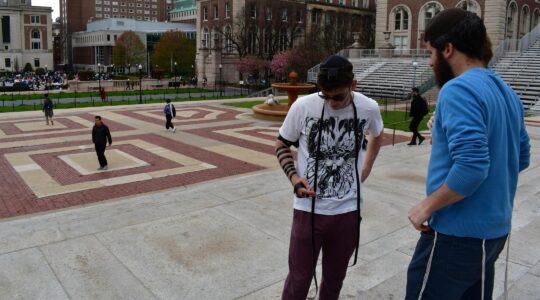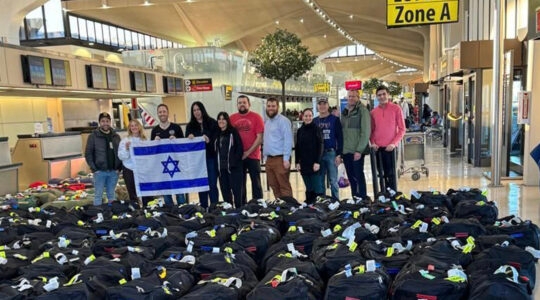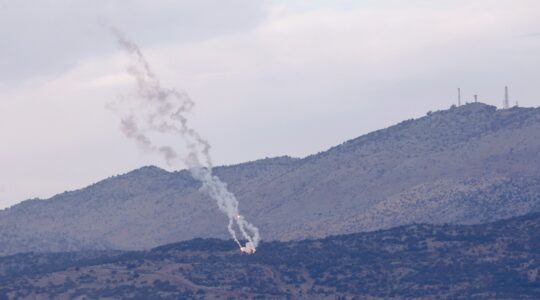SAN FRANCISCO (JTA) – Jews who say the Birkat Hamazon, or prayer after a meal, sing the first few lines to an upbeat melody recognizable to Jews all over the world.
It’s a well-established ritual that goes back … well, to when?
Not that far, actually.
This singsong way of saying the prayer was developed as a teaching device by Mordecai Kaplan, the early 20th century rabbi who became the founder of Reconstructionist Judaism. It was adopted by his students and gradually became widespread.
“People think it goes back to the time of Moses,” quipped Jonathan Sarna, a professor of American Jewish history at Brandeis University. “Once rituals are around for a while, we assume they have been around forever.”
Jewish rituals, like those of any other culture, emerge at specific points to respond to needs and values that are constantly evolving.
Some last and are absorbed into the general lexicon. Examples are the Friday night Kabbalat Shabbat service, developed by the 16th century kabbalists of Safed and now considered sacrosanct, or mixed seating in the synagogue, an innovation of early 20th century Reform Judaism.
Other rituals do not have the same staying power and are discarded.
The delicate process of creating and integrating new Jewish rituals in America today is explored in the new book “Inventing Jewish Ritual,” by Vanessa Ochs, associate professor of religious studies at the University of Virginia in Charlottesville.
Ochs examines the genesis and adaptation of many well-accepted contemporary rituals in American Jewish life, including baby-naming ceremonies for girls, adult b’nai mitzvah and rosh hodesh groups, as well as others just emerging, such as Torah yoga and alternative uses of the mikvah.
While showing how those that succeed manage to find a hook for their new practices from within Jewish tradition, thus giving authenticity to innovation, Ochs points out that American Judaism is in a particularly fertile period today. New practices are cropping up with increasing speed in the synagogue and out in the world.
She attributes that growth to the influence of feminism and what she calls “democracy,” or the notion that individuals have the right to develop their own ways of accessing the divine.
Sarna adds that the idea of ritual itself has been rehabilitated, as early 20th century anthropological disdain for rituals as a hallmark of primitive cultures slowly mellowed.
“Within a century, the idea of a ritual as something primitive that should be discarded by moderns has been transvalued into something that makes us human and should be celebrated,” he explains.
While it takes time for a new practice to become the norm, Ochs believes that it happens much faster than it used to, even in the Orthodox community, which traditionally has been viewed as the most reluctant to take on new practices. Bat mitzvah ceremonies, another Kaplan invention, are fairly well the norm today in Orthodox circles, as are rosh hodesh groups.
On the other hand, those who come up with new ceremonies or practices rarely refer to them as rituals either because they don’t recognize, or don’t think they have the right to recognize, the significance of what they have created.
In fact, Ochs says, most Jewish rituals were developed by Jewish families in their homes or via other grassroots methods.
One such example involves the hundreds of Torah scrolls, many rescued from the Holocaust, that have been restored and donated to congregations in the former Soviet Union in the past decade. They are usually handed over to the new congregation during a ceremony constructed for the occasion by the donating and/or receiving group. Those ceremonies, Ochs suggests, are part of an emerging ritual.
Project Kesher, an organization of Jewish women activists from North America and the former Soviet Union, has donated 14 Torah scrolls to congregations in Russia and Ukraine. Each is handed over during a festive ceremony in the recipients’ home city.
The executive director of Project Kesher, Karyn Gershon, says the women involved “absolutely” are aware that they are creating a Jewish ritual.
In 2004, when the first six scrolls were donated, Kesher staff made Torah mantles from fabric purchased on Jerusalem’s Ben-Yehuda Street combined with pieces of velvet from Russia, “so each has a piece of Israel and of Russia,” Gershon explains.
Each donor handing over a scroll was presented with her own prayer shawl on which Gershon embroidered the name of the city where her Torah was going to concretize the connection.
A ritual for donating Holocaust Torahs is one thing. But what about one for buying a new car, which is what Ochs’ 23-year-old daughter demanded during a recent telephone call.
“She called and said, ‘I just sold my car, the guy has the keys in his hand, what’s the ritual I should do?’ ” Ochs related, laughing at how fully the idea of finding ways to make anything Jewish has permeated the American Jewish consciousness.
“This generation of young people believes they can use Jewish language and core beliefs to fashion new rituals,” she said. “They know it’s not transgressive to do so.”





